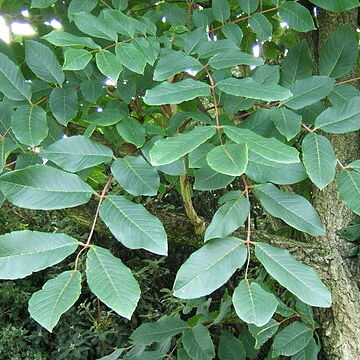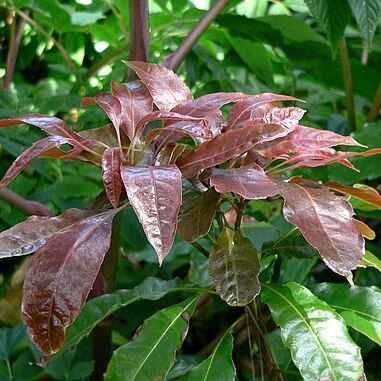Evergreen or sometimes deciduous shrubs or trees, up to 42 m, 1 m diam., sometimes buttressed. Twigs more or less lenticellate, often with conspicuous leaf-scars. Buds densely pubescent. Leaves simple or imparipinnate with (sub)opposite leaflets, ending in 3 or 1 leaflet(s), in the latter case its petiolule articulated with the rachis; leaves or leaflets entire or dentate, with or without hairy domatia beneath; rachis and petioles, usually also petiolules, with a usually shallow and narrow, more or less conspicuous longitudinal groove above, usually with swollen base, articulately attached. Inflorescence terminal, sometimes axilláry, a pyramidal panicle, poor to usually profuse, up to 4 times ramified, with alternate, articulately attached, often lenticellate axes. Bracts small, those of lower order usually soon caducous; cataphylls often present. Bracteoles absent, but sometimes one (or two) bracteole-like sepals present, lowered on the pedicel. Flowers numerous, sessile or short-pedicelled, small, bisexual. Sepals 5, by reduction sometimes 4, rarely 3, sometimes by addition of empty bracts seemingly more, up to c. 13, and together forming a kind of involucre, usually unequal and then mostly 3 about equal. Petals 5, episepalous, 3 outer ones more or less unequal, alternisepalous, mostly suborbicular and convex, rarely the largest one much wider than long and more or less reniform, the smaller ones irregularly shaped; 2 inner ones equal, much smaller, reduced, opposite the fertile stamens and more or less adherent to the base of the filaments, entire to bifid. Disk generally present, sometimes very reduced or absent, often irregularly shaped, as a rule with 5 more or less developed teeth, 4 of which paired, 1 unpaired, each pair opposite a fertile stamen. Stamens 5, epipetalous, 2 fertile, filament short, strap-shaped, flat, incurved at the top, abruptly terminating in a wide, varyingly shaped cup which bears two globose to elliptic transversely dehiscent anther-cells which are ripe in bud, springing back elasti-cally when the flower opens; 3 staminodial, opposite the larger petals and more or less adherent to the base of these, deformed, broad, irregularly shaped, with 1 or 2 holes near the top in which fit the anther-cells of the fertile stamens, often coherent and forming a cup over the pistil. Ovary globose to ovoid or conical, 2-, very rarely 3-locular, apically contracted in a rather short, simple or 2-partible, cylindric or subulate to conical, rarely minute style, with simple or somewhat bifid, minute stigma. Ovules 2 (or 1) in each cell, more or less superimposed, attached to the partition, hemi-anatropous. Fruit a drupe, subglobose to pyriform, small, glabrous, with one stone; rarely two ovules instead of one per ovary develop, resulting in a didymous fruit; mesocarp pulpy, mostly thin; endocarp globose, pyriform, or semiglobose, 1-celled, stony to crustaceous, splitting in two valves, inside with a basilar rounded projection over which the seed is curved. Vascular bundle connecting pedicel and seed either running outside the endocarp wall (free in the pulpy mesocarp or in a groove on the ventral endocarp wall), or through a canal inside the endocarp wall. Seed sub-to semiglobose, more or less concave at the ventral side, with membranous testa, without endosperm. Embryo with rather long, 2-3 times folded radicle and more or less folded cotyledons.
More
Trees and shrubs, usually evergreen. Leaves alternate (rarely subopposite) frequently clustered at the twig apices, simple (Panama) or pinnately compound, entire or frequently dentate, the petiole usually thickened at base. Inflorescence terminal to cauliflorous, frequently ramiflorous, paniculate, usually pyramidal, the bracts reduced, inconspicuous, the usually numerous flowers sessile or ped-icellate. Flowers small, zygomorphic; sepals 5 (in Panama, rarely reduced to 3 elsewhere); petals 5, the 3 outer ones larger and usually more or less suborbicular, the 2 inner ones much reduced, thin and strap-shaped, opposite the fertile stamens and more or less fused to the filament bases; fertile stamens 2, the filament short, flat, incurved at tip, the anthers bilocular, the thecae short and thick, transversely dehiscent, often separated by the thickened connective, the staminodes 3, op-posite and more or less fused with the bases of the larger petals, sometimes forming a cap over the pistil; ovary globose to conical, bilocular, rarely trilocular, with 2 more or less superimposed ovules in each locule, the style minute to elongate, the stigma minute; disc usually present, typically 5-toothed. Fruit a drupe, globose to obovoid, sometimes with a slight median keel, with a single large seed (rarely with 2 ovules developing per fruit according to Beusekom), the mesocarp thin, the endocarp frequently exceptionally hard: seed more or less globose, usually somewhat concave ventrally, without endosperm.
Trees or shrubs, evergreen or deciduous. Buds naked, brownish tomentose. Leaves simple or odd pinnate, leaves or leaflets entire or often dentate; petiole usually thickened at base. Inflorescence terminal, sometimes axillary, a pyramidal panicle, usually profusely flowered but sometimes sparsely so, up to 4 × branched and very large. Flowers numerous, 1-3 mm in diam., hermaphroditic, zygomorphic, sessile or shortly pedicellate. Sepals [3 or](4 or)5(-9), imbricate, with bracts beneath. Petals 5, imbricate, unequal, 3 outer ones larger, usually suborbicular or reniform, convex, 2 inner ones much smaller, bifid or entire, sometimes 3-lobed, ± adherent to base of filaments of fertile stamens, concealed under outer petals at bud stage. Fertile stamens 2, opposite 2 inner petals; filaments flattened, short, incurved at apex into a cup-shaped connective; anthers 2-celled, globose or elliptic; staminodes 3, opposite outer sepals, adherent to their bases. Disk cup-shaped or shallowly cup-shaped, 5-dentate. Ovary sessile, 2(or 3)-loculed, with 1 or 2 ovules per locule. Fruit a drupe, small; mesocarp fleshy; endocarp stony or crustaceous. Seed ± globose, usually somewhat concave ventrally, without endosperm.


